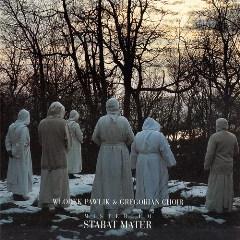Wlodek Pawlik & Gregorian Choir - Misterium Stabat Mater (2001)
Wlodek Pawlik & Gregorian Choir - Misterium Stabat Mater (2001)

1. Ave Maria, Stabant iuxta crucem, Ubi caritas, 2. Oremus, Kyrie, 3. O vos omnes, 4. Sequentia Sancti Evangelii secundum Joannem, 5. Stabat Mater Dolorosa, 6. Ave verum, 7. Oremus, 8. Ave Maria Line-up: Wlodek Pawlik - piano Gregorian Choir of Redemptorists Rev. Stanislaw Madeja - cantor Choir of Sisters if Holy Virgin Mother Female Vocal Quartet
In the beginning of the 17th century the singing of Gregorian chant deteriorated, for a large part caused by a very mutilating edition that came into print, the Medicea-edition. The Benedictine monks of the abbey in the French village of Solesmes, however, took up a thorough study of all old sources and tried to reconstruct the chants as good as possible. The monk Dom Fonteinnes reconstructed the Stabat Mater chant around 1850. An old source of the Stabat Mater chant can be found in the Maintzesch Gesangbuch from 1661.
In the early years of the twentieth century, after centuries of deterioration, Pope Pius X assigned the Benedictine abbey in Solesmes to assemble the reconstructed chants in an official edition of Gregorian chants, called the Editio Vaticana.
An interesting interpretation, quite different, is by the Polish jazz pianist Wlodek Pawlik On Good Friday of the year 2000 a concert was organized were monks and nuns sang the Gregorian chants, while Pawlik added his improvisations. ---stabatmater.info
Eight parts of the misterium are set according to the order of the Mass. The piano improvisations follow every part of the Mass. Quite often the pianist plays along the choir's melodic lines and builds his own harmonies and textures over the traditional choral melodies. The philosophical and aesthetic depth of this music is unquestionable. The pianist and the choir create a mystical atmosphere of an existential contemplation. Since the material was recorded live in a holy church, the acoustics and the space make each note speak with its own unique meaning. Włodek Pawlik's „Stabat Mater” combines elements of a profound prayer with a creative approach to medieval and contemporary music. It's like a bridge built over the history of humanity linking its remotely separated periods ---Marek Dusza, Rzeczpospolita
O ile płyty ze swingującymi kolędami, trafiają do odbiorców regularnie, o tyle jazz inspirowany Wielkim Tygodniem był dotąd białą kartą. Tę, w sposób piękny i przejmujący, wypełnia wirtuoz fortepianu, Włodek Pawlik. Artysta wpisuje się nią w rozdział muzyki balansującej między gatunkami, nurt zapoczątkowany spektakularnie przez Jana Garbarka sensacyjnym albumem "Officium" przed pięcioma laty. W przeciwieństwie do Norwega, nasz pianista nie wpisał jazzowych nut w wielogłosowe, z natury więc posiadające określoną harmonię kościelne pieśni, ale stworzył własną jej wizję w oparciu o oryginalne gregoriańskie melodie. Dwa chóry gregoriańskie (Schola Sióstr Służebniczek Dębickich z Tuchowa i Schola Gregoriańska Redemptorystów), żeński kwartet wokalny oraz kantor O. Stanisław Madeja (dyryguje O. Janusz Sok) wykonują coś, co znacznie upraszczając można nazwać tematem na kanwie którego Pawlik buduje swoje improwizacje. Chwilami pozostaje sam, prowadząc bardzo swobodne frazy, rozmyte struktury arpeggiowe, a to wszystko po chwili okazuje się misternym wprowadzeniem kolejnej części (mamy ich łącznie osiem, z początkowym i finałowym "Ave Maria", Kyrie, Ave Verum i obowiązkowym tutaj Stabat Mater Dolorosa w środku). Chwilami głosy traktowane są sonorystycznie (szeptem wypowiadane modlitwy), kiedy indziej śpiew staje się samoistnym podmiotem. Fortepian lidera raz przybliża się do estetyki Keitha Jarretta, kiedy indziej zmierza w rejony znane z ostatniego krążka Lyle'a Maysa, gdzie dźwięk fortepianu posłużył jako materiał wyjściowy do elektronicznej obróbki. Pawlik podobny efekt uzyskał wykorzystując naturalny pogłos Sanktuarium Matki Bożej Tuchowskiej i "żywy" chór. Niestety, zastrzeżenia budzi jakość samego instrumentu, któremu brak blasku (a może to wina nagrania?). Tak czy inaczej, dostajemy album niesamowity, pełen natchnionych dźwięków, stroniący od taniego poklasku. --- wyborcza.pl
download (mp3 @256 kbs):
uploaded yandex 4shared mega mediafire solidfiles zalivalka cloudmailru oboom
Last Updated (Friday, 03 April 2015 13:07)








